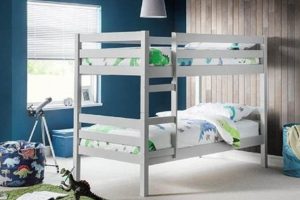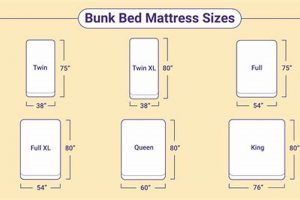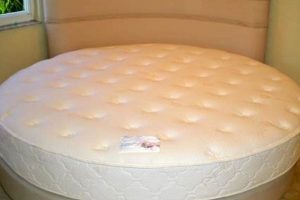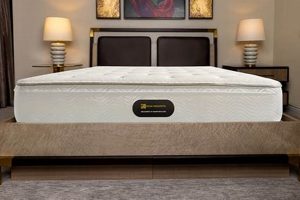A furniture ensemble consisting of a daybed frame combined with a roll-out bed (the trundle) and its accompanying sleep surface provides adaptable sleeping arrangements. This configuration functions as seating during the day and offers an extra sleeping area that conveniently stores beneath the main structure when not in use. A common example includes using this type of bed in a guest room or a child’s bedroom, providing flexibility for visitors or sleepovers.
The significance of this sleeping solution lies in its space-saving design and versatility. Historically, such furniture has been utilized in smaller living spaces to maximize functionality. The benefits include accommodating overnight guests without permanently dedicating space to a full-sized bed, which is particularly valuable in apartments, studios, or multi-purpose rooms. Furthermore, it offers a practical solution for children’s rooms, allowing for sleepovers while maintaining ample play area during daytime hours.
This article will delve into the various design options, mattress considerations, and practical applications of this adaptable furniture piece. Further discussion will explore the factors to consider when selecting this type of bed, including frame materials, trundle mechanisms, and size variations. The aim is to provide a comprehensive understanding to aid in making an informed purchasing decision.
Considerations for Selecting a Daybed Trundle with Mattress
The selection of a daybed with a trundle and accompanying mattress requires careful consideration to ensure optimal functionality, comfort, and longevity. The following tips provide a framework for evaluating available options and making an informed purchase.
Tip 1: Evaluate Space Constraints: Accurately measure the intended location to ensure sufficient room for both the daybed and the extended trundle. Account for clearance around the bed to facilitate ease of movement.
Tip 2: Assess Frame Material and Construction: Opt for durable materials, such as solid wood or metal, that can withstand regular use. Examine the construction quality, paying attention to joint stability and overall sturdiness.
Tip 3: Scrutinize Trundle Mechanism: Investigate the trundle’s rolling mechanism, ensuring smooth and reliable operation. Consider trundles with locking casters for added stability when extended.
Tip 4: Determine Mattress Thickness Compatibility: Verify the maximum mattress thickness the trundle frame can accommodate without obstructing its ability to slide under the daybed. Balance comfort with practicality.
Tip 5: Consider Mattress Type and Support: Select a mattress that provides adequate support and comfort for anticipated users. Memory foam, innerspring, and hybrid options offer varying levels of support and conforming capabilities.
Tip 6: Evaluate Aesthetic Cohesion: Choose a daybed design that complements the existing dcor of the room. Consider the color, style, and overall aesthetic to create a harmonious environment.
Tip 7: Prioritize Ventilation: Inquire about the trundle’s construction and mattress support system to ensure adequate ventilation. Proper airflow minimizes the risk of moisture buildup and mildew formation.
These considerations emphasize the importance of evaluating space, construction, functionality, and personal preferences when selecting a daybed trundle with mattress. Careful attention to these details will ensure a practical and comfortable addition to the living space.
The subsequent sections will explore specific models and brands, providing detailed comparisons to further assist in the decision-making process.
1. Space Optimization
Space optimization represents a core advantage provided by the integration of a day bed trundle with mattress. This furniture configuration directly addresses the challenges presented by limited living areas, offering adaptable functionality without compromising available square footage.
- Dual Functionality
The primary role of this bed arrangement is to serve two distinct purposes within a single footprint. During the day, the unit functions as a seating area, often resembling a sofa or chaise lounge. At night, the trundle can be extended to provide an additional sleeping surface. This duality is particularly relevant in studio apartments or guest rooms where dedicated sleeping quarters are not feasible.
- Vertical Space Utilization
While the day bed occupies a horizontal space, the trundle leverages the underutilized vertical space beneath the main frame. The mattress for the trundle bed is compactly stored underneath the daybed, making it a seamless transition from seating area to a sleeping area, contributing to a decluttered living environment.
- Adaptable Room Configuration
The day bed with trundle facilitates dynamic room configuration. A room can quickly transform from a daytime living space to a nighttime sleeping area. This adaptability supports multi-purpose room design, enabling a single space to serve various functions without requiring significant rearrangement or the introduction of bulky, space-consuming furniture.
- Storage Integration
Beyond the primary function of providing additional sleeping space, some models incorporate integrated storage solutions. Drawers or shelves can be built into the day bed frame or the trundle unit itself, offering further opportunities to optimize space by consolidating belongings within the furniture’s structure. This feature addresses the challenge of limited storage options often encountered in smaller living spaces.
The space-saving advantages afforded by this furniture arrangement are substantial, making it an attractive solution for urban dwellers, small families, and anyone seeking to maximize the utility of limited living space. By combining seating, sleeping, and storage capabilities into a single unit, this style of bed optimizes available space while offering adaptable functionality.
2. Sleeping Versatility
Sleeping versatility, as a core component of a day bed trundle with mattress, directly influences its practical utility and appeal. The cause-and-effect relationship is straightforward: the inclusion of a trundle expands the sleeping capacity of the day bed, thereby increasing its versatility. A day bed without a trundle offers a single sleeping surface, limiting its ability to accommodate additional overnight guests or provide flexible sleeping arrangements within a single room. The importance of this versatility lies in its ability to adapt to varying spatial and occupancy needs.
For example, consider a home office that also serves as a guest room. A day bed alone would only comfortably accommodate one visitor. However, incorporating a trundl
e provides a second sleeping surface, effectively doubling the room’s guest capacity without necessitating a larger, permanently installed bed. Another practical application is within children’s rooms, where the trundle facilitates sleepovers while conserving floor space during daytime activities. The ability to quickly and easily convert the day bed from seating to a double-sleeping arrangement enhances its overall functional value. The versatility also extends to diverse sleeping preferences; some may prefer the firmness of the day bed mattress, while others may prefer the trundle mattress.
Understanding this connection is significant because it guides consumer purchasing decisions and design considerations. The trundle’s inclusion directly affects the day bed’s ability to adapt to diverse needs, making it a practical solution for spaces where flexibility and space conservation are paramount. While challenges may arise in terms of ensuring mattress compatibility and smooth trundle operation, the benefits of enhanced sleeping versatility typically outweigh these concerns, solidifying the day bed trundle with mattress as a versatile furniture option.
3. Frame Durability
Frame durability constitutes a critical factor in the longevity and functionality of a day bed trundle with mattress. The frame provides the structural support for both the day bed and the trundle, bearing the weight of mattresses and occupants. A weak or poorly constructed frame can lead to premature wear, instability, and eventual failure, negating the benefits of space-saving design and sleeping versatility. The material composition and construction methods directly influence the frame’s ability to withstand daily use and the stresses associated with extending and retracting the trundle. For instance, solid hardwood frames, when properly joined, offer superior strength and resistance to warping compared to frames constructed from particleboard or lower-grade materials. The trundle mechanism itself, including the casters and support system, also requires robust construction to ensure smooth operation and prevent collapse under load.
The importance of frame durability is evident in real-world applications. In a child’s bedroom, a day bed trundle might endure frequent use and potentially rough treatment. A durable frame will withstand this usage, ensuring the bed remains safe and functional. Conversely, a flimsy frame could buckle or break, posing a safety hazard. Similarly, in a guest room, a day bed trundle should provide reliable support for occupants of varying weights. A durable frame provides this assurance. The practical significance lies in long-term cost savings. Investing in a high-quality, durable frame reduces the likelihood of repairs or replacements, ultimately proving more economical than choosing a cheaper, less robust option. Furthermore, a sturdy frame contributes to the overall comfort and stability of the bed, improving the user’s sleep experience.
In summary, frame durability is not merely a superficial feature but an essential component of a day bed trundle with mattress. It directly affects the bed’s safety, longevity, and overall value. Choosing a frame constructed from durable materials and employing robust construction methods is crucial for ensuring the bed’s functionality and providing a comfortable and reliable sleeping solution. Overlooking this aspect can lead to premature failure and compromise the benefits this type of furniture offers.
4. Mattress Comfort
Mattress comfort directly influences the overall satisfaction and usability of a day bed trundle with mattress. The functional design of this furniture arrangement aims to provide both seating and sleeping accommodations. The primary effect of a comfortable mattress is enhanced sleep quality for the user, while conversely, an uncomfortable mattress compromises rest and diminishes the perceived value of the entire unit. Mattress comfort, as a component, contributes significantly to the versatility and practicality inherent in this dual-purpose furniture piece. Examples include a guest room scenario where providing a comfortable sleeping surface ensures a positive guest experience, and in a child’s bedroom, a comfortable mattress promotes restful sleep, impacting overall well-being.
The practical significance of understanding this connection extends to purchase decisions. A consumer evaluating this sleeping solution must prioritize mattress selection. This entails considering factors such as mattress type (e.g., memory foam, innerspring, hybrid), firmness level, and thickness, ensuring compatibility with the trundle frame’s size restrictions. Furthermore, the mattress should provide adequate support to prevent discomfort or potential musculoskeletal issues. The choice of mattress directly impacts the functionality of the sleeping setup, influencing usability. Selecting a mattress without proper consideration can undermine the functionality.
In summary, mattress comfort is an inseparable component of the entire experience. Challenges may arise from balancing mattress thickness with the trundle’s storage constraints, or differing comfort preferences among potential users. Recognizing the interdependencies between these components enables better purchasing decisions. Choosing the proper mattress guarantees that the day bed with trundle effectively fulfills its dual-purpose nature and provides a valuable and effective sleep solution.
5. Storage Efficiency
Storage efficiency, concerning a day bed trundle with mattress, involves optimizing available space by integrating storage capabilities into the furniture’s design. This aspect enhances the bed’s overall practicality, particularly within space-constrained environments. The efficient use of space becomes a critical determinant of the value proposition offered by the design.
- Under-Bed Trundle Compartment
The primary storage facet is the trundle compartment itself. This space, typically occupied by a second mattress, can be configured to accommodate drawers or shelving units when a trundle bed is not required. Examples include storing seasonal clothing, linens, or other household items that would otherwise occupy closet or storage unit space. The implications are twofold: it declutters the living area and provides easy access to stored items.
- Integrated Side Drawers
Some day bed designs incorporate drawers along the sides or front of the frame. These drawers offer convenient storage for smaller items such as books, electronics, or personal belongings. The integration of side drawers eliminates the need for separate nightstands or storage chests, further conserving floor space. A real-world example includes stowing away remote controls and gaming accessories within a living room setting.
- Headboard Storage Solutions
Select day beds feature headboards with built-in shelving or compartments. This design element provides vertical storage for items such as books, picture frames, or decorative objects. By utilizing the vertical space above the bed, headboard storage contributes to overall storage efficiency and reduces clutter on nearby surfaces. The implications include optimizing available space and promoting a more organi
zed living environment. - Optimized Frame Dimensions
Even without dedicated storage compartments, the day bed frame itself can be designed to minimize its footprint while maximizing internal storage volume (if a trundle is not used). This optimization involves streamlining the frame’s dimensions and selecting materials that allow for thinner profiles without sacrificing structural integrity. The effect is a reduction in the bed’s overall spatial impact and the potential to repurpose the trundle space for alternate storage functions.
These storage solutions synergistically enhance the utility of a day bed trundle. By integrating storage capabilities directly into the furniture’s design, the bed becomes a multi-functional asset, addressing both sleeping and storage needs. This approach is particularly advantageous in smaller living spaces where optimizing every square foot is essential. The overall effect is a more organized, efficient, and functional living environment.
Frequently Asked Questions
This section addresses common inquiries concerning the selection, functionality, and maintenance of a day bed trundle with mattress. The information provided aims to clarify key aspects and assist in making informed purchasing decisions.
Question 1: What are the primary advantages of a day bed trundle versus a standard bed frame?
A day bed trundle offers space-saving versatility. It functions as seating during the day and can readily convert to a sleeping arrangement for one or two individuals. This adaptability is particularly advantageous in rooms with limited space.
Question 2: How is the weight capacity determined for both the day bed and the trundle unit?
Weight capacity is contingent on the frame’s construction materials, joinery, and support system. Manufacturers typically provide weight limits for both the main day bed frame and the trundle unit. Exceeding these limits may compromise the structural integrity of the bed.
Question 3: What mattress types are most suitable for day bed trundles, considering height limitations?
Mattress selection is dictated by the trundle’s clearance when stored beneath the day bed. Low-profile mattresses, generally innerspring or foam options, are frequently recommended to ensure the trundle can be easily rolled in and out. Specific height restrictions should be verified with the product specifications.
Question 4: What maintenance procedures are recommended to prolong the lifespan of a day bed trundle?
Regular cleaning of the frame, vacuuming of the mattress, and periodic tightening of hardware are recommended. Avoid exceeding the stated weight limits. Inspect the trundle’s rolling mechanism periodically to ensure smooth operation.
Question 5: Can the trundle unit be used independently of the day bed frame?
The ability to use the trundle unit independently depends on the design. Some trundles are designed as self-contained units with their own legs or support structure, allowing for independent use. Others rely on the day bed frame for support and cannot be used separately.
Question 6: Are there specific safety considerations to keep in mind when using a day bed trundle, particularly with children?
Ensure the trundle mechanism operates smoothly and is free from obstructions. When children are using the bed, supervise the extension and retraction of the trundle to prevent injuries. Verify the mattress fits snugly within the frame to eliminate gaps that could pose a safety hazard.
These FAQs serve as a general guide. Refer to the manufacturer’s specifications and instructions for detailed information regarding a specific model of day bed trundle with mattress.
The subsequent section will explore strategies for optimizing the aesthetic integration of a day bed trundle within various interior design styles.
Conclusion
This article has explored the multifaceted nature of the day bed trundle with mattress, emphasizing its dual role as a space-saving seating solution and a versatile sleeping arrangement. Key aspects examined include space optimization, sleeping versatility, frame durability, mattress comfort, and storage efficiency. The practical applications of this furniture piece within various living spaces, from compact apartments to multi-functional rooms, have been highlighted, alongside essential considerations for making informed purchasing decisions.
The selection of a day bed trundle with mattress represents a significant investment in both functionality and design. Careful evaluation of individual needs, space constraints, and quality parameters is crucial to realizing the full potential of this adaptable furniture solution. By prioritizing durability, comfort, and efficient space utilization, consumers can ensure that this addition contributes positively to their living environment and fulfills its intended purpose for years to come.




![Best Simmons Bunk Bed Mattress [Guide] for Kids Sleep Organic & Natural Mattress Buyer’s Guide: Non-Toxic Sleep Solutions Best Simmons Bunk Bed Mattress [Guide] for Kids Sleep | Organic & Natural Mattress Buyer’s Guide: Non-Toxic Sleep Solutions](https://mattressworldpa.com/wp-content/uploads/2025/07/th-7078-300x200.jpg)
![RV Bunk Bed Bliss: Choosing the Perfect Mattress [Guide] Organic & Natural Mattress Buyer’s Guide: Non-Toxic Sleep Solutions RV Bunk Bed Bliss: Choosing the Perfect Mattress [Guide] | Organic & Natural Mattress Buyer’s Guide: Non-Toxic Sleep Solutions](https://mattressworldpa.com/wp-content/uploads/2025/07/th-7077-300x200.jpg)

